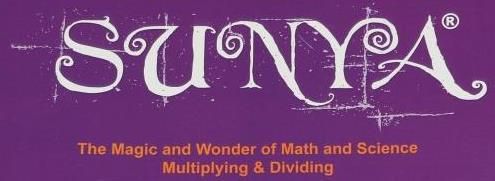What is Sunya?
Sunya, which means empty in Sanskrit, is a card game. It comes with a guidebook, 30 math and science fact and riddle cards, and 60 Sunya playing cards (there are numbers and wild cards). The set came with a number line to help count if you're not sure of a fact. We received the multiplying and dividing game, but there is also an addition and subtraction game available. This is a rather new company and the guidebook we received was printed with some pages in black and white and some in color. The reviewers were asked which they preferred. We like the color pages, they are easier to read through because the bold words and the cards in examples are color coded. The set came in a large envelope so the guidebook was a little bent by the time we received it, though not damaged.How did we use Sunya?
It took me a while to figure out the instructions in the guidebook, they are wordy and confusing at times. As soon as I cleared all distractions and really focused, I figured it out. A few pages tell about variations in the game, and alternate games to play. There are some pages in the guidebook that are unnecessary, the fact and riddle cards are reprinted in it. Though I suppose that is helpful if one of these cards gets lost. The guidebook includes information on the meaning of Sunya and some historical information which is interesting to read.The game begins with one number sentence laid out, and each player is dealt 4 cards. The object of the game is to lay down all of your number cards, saying "Sunya!" to indicate you have done so to win. Each player takes turns and attempts to alter the number sentence laid on the floor using cards in their hand. If they cannot, they draw one card at a time until they can change the number sentence.
There are some extra rules such as 1 and 0 cannot be used in a multiplication problem, only in the answer. Otherwise everyone just tries to get one or two of each card and create problems like 1x9=1 and 0x6=0. The division game is played the same way as multiplication, with reversed number sentences of course!
Once we figured out how to play I was surprised at how much my kids enjoyed this game! They would play together often. The rule book suggests that each player lay their hand in front of them so the cards are not secret. This way everyone helps each other out, and in my home that meant the preschooler could play this game with the big kids! My oldest, 7th grade, could find number combinations to play quickly but she was very patient with my 2nd grader and would only help when asked.
When one person wins a round, they read one fact/riddle card. Of course the kids read all the cards as soon as they realized what they were, so now everyone knows the answers on them. But they have fun sharing cool facts or tricking people who haven't read the riddle cards yet (like Dad when he comes home from work.)
This has been a fun way to review math facts, and we will continue to use it. The extra thinking necessary to translate single digits on cards to a complete math fact seems to get the wheels turning in my children's brains! Since this company is so new, I hope they will go through the guidebook and make it easier to understand, and print it in full color. The game wasn't fun at first when my 5th and 7th graders couldn't even figure out what the instructions were. But it was worth taking some extra time to figure it out, because we've really enjoyed a new way to practice math facts!
Where to find Sunya:







so what does Sunya mean?
ReplyDeleteIt means empty, so you would say sunya when your hand is empty.
ReplyDeletewell written review. :)
ReplyDelete